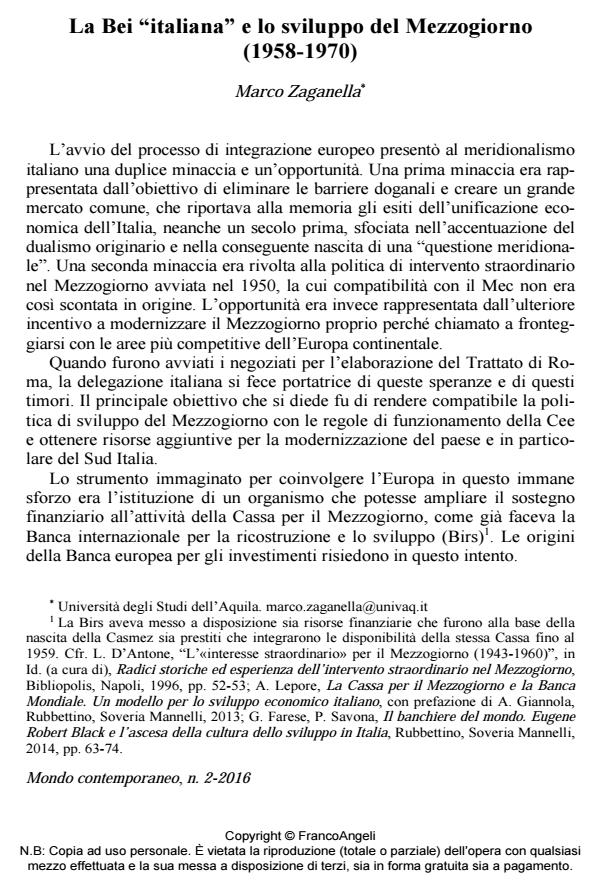The "Italian" EIB and the development of Southern Italy (1958-1970)
Journal title MONDO CONTEMPORANEO
Author/s Marco Zaganella
Publishing Year 2016 Issue 2016/2
Language Italian Pages 26 P. 61-86 File size 233 KB
DOI 10.3280/MON2016-002003
DOI is like a bar code for intellectual property: to have more infomation
click here
Below, you can see the article first page
If you want to buy this article in PDF format, you can do it, following the instructions to buy download credits

FrancoAngeli is member of Publishers International Linking Association, Inc (PILA), a not-for-profit association which run the CrossRef service enabling links to and from online scholarly content.
The beginning of European integration represented for the government’s policy in favor of Southern Italy both a dual threat and an opportunity. The first threat was given by the removal of trade barriers and the creation of a large common market, a process that recalled the early economic unification of the country, which had ultimately emphasized the economic differences between Northern and Southern Italy. The second threat addressed the extraordinary intervention policy launched by Italy’s government in 1950: it was arguable, in fact, whether this policy would remain possible in light of the new Common Market rules. A new opportunity, instead, was given by the increased incentive to modernize the South, since this was expected to become competitive with the most developed areas of continental Europe. To address these hopes and concerns, the Italian delegation charged to negotiate the Treaty of Rome proposed to create an instrument able to allocate additional economic resources in favor of disadvantaged areas. The origins of the European Investment Bank, therefore, lay in this effort to support the South of Italy. This country paid close attention to the work of the EIB from 1958 to 1970, at the time when this institution was chaired by Pietro Campilli and Paride Formentini.
L’avvio del processo d’integrazione europeo rappresentò per il meridionalismo italiano una duplice minaccia e un’opportunità. Una prima minaccia era costituita dall’obiettivo di eliminare le barriere doganali e creare un grande mercato comune, che riportava alla memoria gli esiti dell’unificazione economica dell’Italia, sfociata nell’accentuazione del dualismo originario. Una seconda minaccia era rivolta alla politica di intervento straordinario nel Mezzogiorno avviata nel 1950, la cui compatibilità con il Mec non era così scontata in origine. L’opportunità era invece rappresentata dall’ulteriore incentivo a modernizzare il Mezzogiorno, chiamato a fronteggiarsi con le aree più competitive dell’Europa continentale. Per rispondere a queste speranze e a questi timori, la delegazione italiana incaricata di negoziare il Trattato di Roma propose la costituzione di uno strumento in grado di convogliare risorse aggiuntive per lo sviluppo del Sud Italia. Le origini della Banca europea degli investimenti risiedono in questo intento. L’Italia prestò grande attenzione a questa istituzione tra il 1958 e il 1970, quando fu presieduta da Pietro Campilli e da Paride Formentini.
Keywords: European Investment Bank, European Economic Community, Common Market, Southern Italy, Pietro Campilli, Paride Formentini
Marco Zaganella, La Bei "italiana" e lo sviluppo del Mezzogiorno (1958-1970) in "MONDO CONTEMPORANEO" 2/2016, pp 61-86, DOI: 10.3280/MON2016-002003